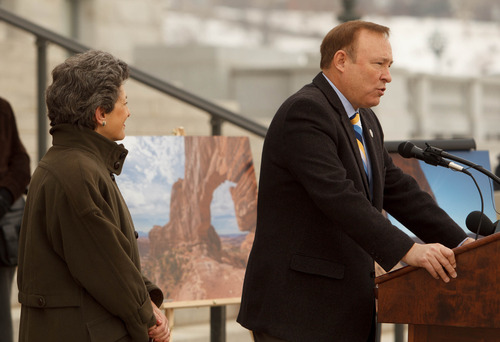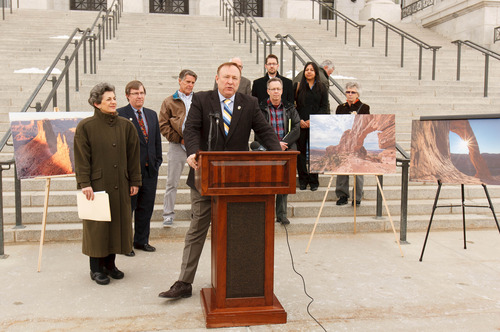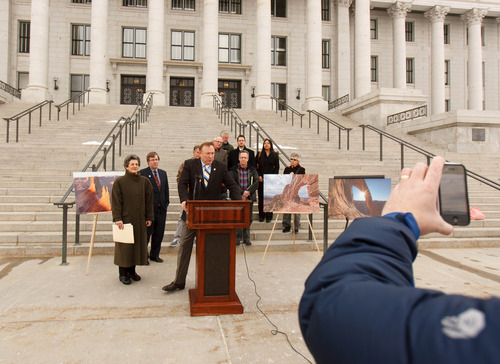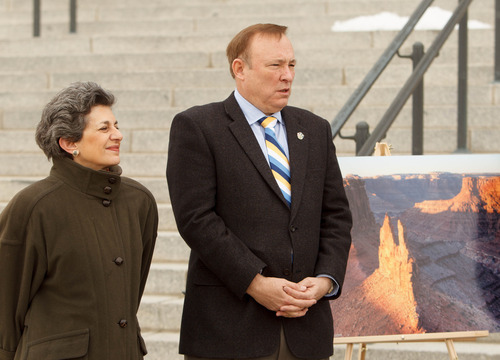This is an archived article that was published on sltrib.com in 2013, and information in the article may be outdated. It is provided only for personal research purposes and may not be reprinted.
It's the largest remaining block of undeveloped land in the lower 48. The Greater Canyonlands region is also among the world's most scenic places, widely considered a national treasure, and Democratic Utah lawmakers want the federal government to take immediate steps to protect this 1.5-million-acre red rock maze of canyons, mesas, spires, natural bridges and arches, and mountains in the southeast corner of the state.
A joint resolution introduced Tuesday, however, does not ask President Obama to invoke the Antiquities Act to designate the monument proposed by the outdoor recreation industry, but rather seeks to gather public input in a transparent process for deciding how best to preserve this largely federally-owned landscape.
"We hope to bring a calm, rational, productive and civil discussion full of facts and figures about what should be protected as the premier recreational lands in the United States," said sponsor Sen. Jim Dabakis during a news conference Tuesday on the Capitol steps. "It's a great treasure we have been given stewardship over. We are open to what kind protections should be built."
His SJR10 calls for preserving this world-famous landscape as "a natural, pristine, and undeveloped area for enjoyment, recreation, and use of current and future generations." It seems tailored to avoid the kind of political blowback that arose with President Bill Clinton's 1996 designation of the Grand Staircase-Escalante National Monument. But the resolution was still met with skepticism from San Juan County, which hosts much of the acreage proposed for protection, along with Grand, Wayne, Emery and Garfield counties.
"We have 11 designations in this county to protect the land. Is one more designation going to do more?" county Commissioner Bruce Adams asked. "We don't need added protections in San Juan County. We are already trying to provide services with the 8 percent of the land in private property that we can tax."
He noted that most outdoor recreationists who visit his remote corner of the state come from metro areas.
"When they get lost or when they get hurt, who do they want to rescue them? They don't call Salt Lake County, they call San Juan County," Adams said.
But conservationists say recreation is the "highest and best use" of this area, which faces pressure from extractive industries. Exploratory drilling for potash is under way near Hatch Point and large deposits of tar sands underlie the western parts of the region proposed for protection.
"Greater Canyonlands' remoteness has preserved historic and scientific resources beyond the national parklands and provided unmatched opportunities for research, solitude, and renewal from a largely untapped library of 12,000 years of human history, an unparalleled story of the southwestern frontier spanning from Ice Age mammoth hunters to ancestral puebloans to pioneers, early settlers, and uranium prospectors," wrote Dabakis in his first piece of legislation since assuming the seat vacated by Ben McAdams after his election as Salt Lake County mayor. Dabakis continues to serve as state Democratic Party chairman.
On Tuesday he was joined by House sponsor, Patrice Arent of Millcreek and other Democratic lawmakers, sportsmen, outdoor recreation enthusiasts, conservationists, and nature writer Stephen Trimble in extolling the spiritual and economic values of the canyon country they hope to keep unmarred for recreation of all kinds.
"It's a place where we can heal our wounds," said military veteran Steve Thiese.
The landscape these interests want protected surrounds the 338,000-acre Canyonlands National Park, which covers the confluence of the Green and Colorado rivers and is visited by 440,000 people a year. The resolution lays out a case that more protection is warranted and will serve the greater good, arguing this landscape "rivals the Grand Canyon in importance and scale."
Outdoor recreation generates $5.8 billion annually in economic activity in Utah, supports 65,000 jobs and adds nearly $300 million to state coffers, said Black Diamond Equipment executive Mark Ritchie, who backs the resolution.











